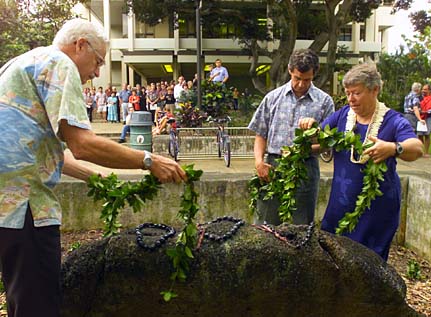
GEORGE F. LEE / GLEE@STARBULLETIN.COM
Ted Murphy, left, Bob Rocheleau and Joyce MIller placed maile leis on a memorial to the missing crewmembers of the research ship Holoholo during rededication ceremonies Friday at the University of Hawaii Marine Sciences Building.
Garden honors 3
UH scientists lost at seaIt takes the place of an older
one dedicated to the 1978 loss
of those aboard the Holoholo
A new memorial garden honoring three University of Hawaii scientists lost with the vessel Holoholo in December 1978 was rededicated during a poignant ceremony Friday.
Chief Scientist Gary Niemeyer, Michael Allen and Robert Harvey were among 10 people on the ship when it left Snug Harbor on Dec. 9 and failed to rendezvous at Kawaihae Harbor on Dec. 11 to exchange scientists.
Joyce Miller, with the Joint Institute for Marine & Atmospheric Research; Ted Murphy, scientific technician at the Pacific Biomedical Research Center; and Bob Rocheleau, engineer with SEA Engineering Inc., presented emotional remembrances of their friends and colleagues lost at sea.
Niemeyer, 31; Harvey, 39; and Allen, 29, were described as enthusiastic and dedicated to the university, their research and the sea.
Meteorology Department Chairman Tom Schroeder read a letter from Niemeyer's wife, Susan, who said her husband felt so lucky because he loved his job and was part of a team doing research "to solve real problems."
UH marine scientists placed three gold trees and a plaque next to the Institute of Geophysics building at UH-Manoa shortly after the tragedy to commemorate the scientists.
But after one tree died and the others weren't doing well, concerned scientists petitioned the university's landscape committee for a new memorial design and restored plaque.
Schroeder and oceanography professors Dave Karl and Roger Lukas worked with the committee and building and grounds management staff on the project.
The new memorial, designed by Janet Gilmar and funded by donations, was dedicated by a small group last Dec. 18 on the 25th anniversary of the Holoholo's disappearance.
The intriguing mystery of the ill-fated Holoholo, which received wide local, national and international news coverage, was recalled during the ceremony.
In rededication remarks Friday to an overflowing audience in the marine sciences auditorium, Karl said the Holoholo was conducting "very important research for Hawaii and the nation" when it disappeared.
It was chartered to the UH Research Corporation for survey work related to the Ocean Thermal Energy Conversion project at Keahole on the Big Island.
The Holoholo wasn't designed as a research vessel but was a diesel-powered pleasure craft, Karl said, noting its name means "Let's go out and have some fun."
Aboard were the owner, John Laney; skipper Michael Trens; one crewmember, John Rusekas; and seven scientists. Besides those from UH were Robert Charnell and Norman Laird from the National Oceanic and Atmospheric Administration's Pacific Marine Environmental Laboratory, and James Sandusky and Stephen Shannon from the University of California's Lawrence Berkeley Laboratory.
Karl described serious safety problems with the Holoholo, pointing out it was a flat-bottom vessel --"not the kind of vessel you want to go into an open ocean with."
The weather deteriorated after the Holoholo left Honolulu, with gale-force winds and high seas in the Molokai Channel where the vessel was headed, Karl said.
About six days after the Holoholo failed to arrive at Kawaihae, a fisherman found a current meter off the Big Island's southwestern coast that was to have been deployed at the OTEC site, Karl said.
A high altitude U-2 aircraft reconnaissance flight Dec. 18 showed a hull adrift about 75 miles south-southeast of the OTEC site believed by some to match the Holoholo.
Many issues were raised and controversies triggered during a U.S. Coast Guard and National Transportation Safety Board inquiry .
Rumors flurried that the Holoholo mission was "classified" with secret government involvement, that Harvey may have been the target of a kidnapping plot because he had been on a Russian research vessel, that Russian spy satellites were observing the Holoholo and that a submarine collided with the Holoholo.
The inquiry concluded that high seas and flooding could have caused the Holoholo to sink and that the accident could have been prevented if the university and the vessel's owner had followed standard safety procedures.
Those who were close to the lost men "are still haunted by the fact that there is still no explanation for this tragedy," Karl said.
He cited this line from a poem written by Harvey's sister, Ann Day, for a 1979 commemorative service for those lost aboard the Holoholo: "They were adversaries, and the sea won -- that's all."
